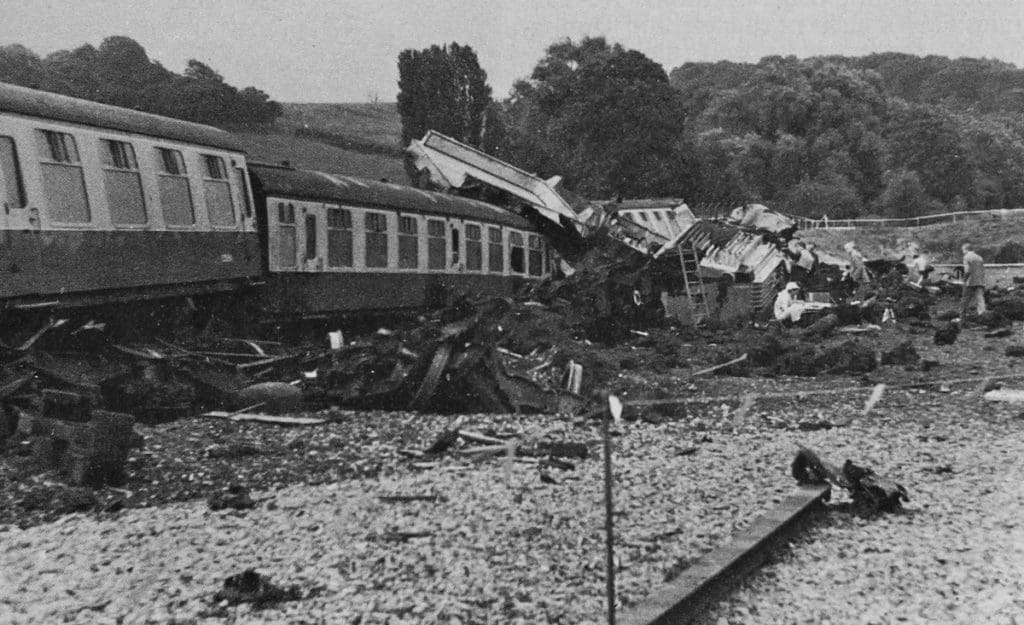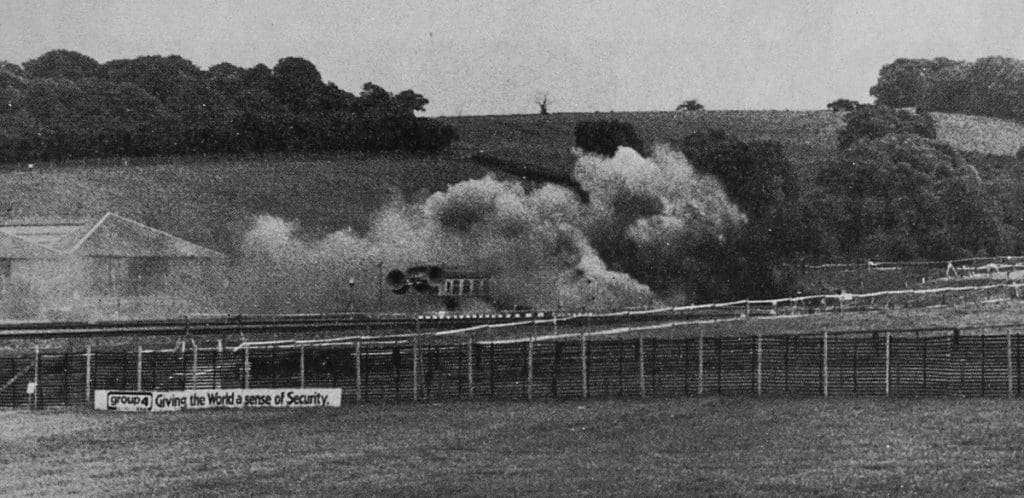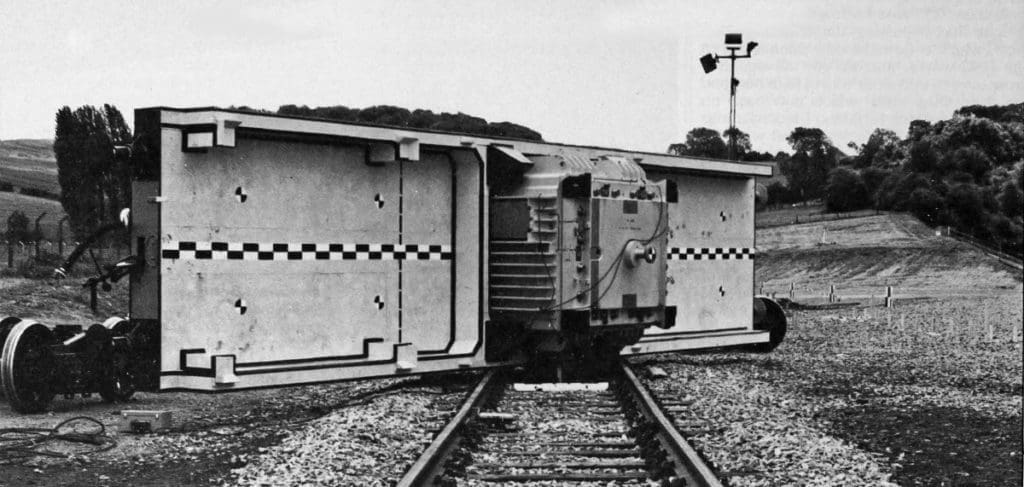In 1984, British Railways and the Central Electricity Generating Board deliberately destroyed a train to prove the safety of nuclear fuel flasks. Here’s how the crash was reported on in the October 1984 issue of The Railway Magazine.

At lunchtime on Tuesday July 17, class “46” locomotive No. 46 009 and three Mkl coaches. Nos. E25154. M4514 and E25564. crashed at 100 m.p.h. into a derailed “Flatrol” wagon, loaded with a steel flask of of the type used for carrying irradiated fuel rods from nuclear power stations to the works of British Nuclear Fuels Limited in Cumbria. for reprocessing.
However, this was no accident. but part of a four—year £4m programme of tests on full—size nuclear fuel flasks undertaken by the Central Electricity Generating Board to allay any public disquiet on the ability of these vessels to stand up to the severest forms of accident. The flask in the test. which was loaded with three tonnes of steel bars to simulate nuclear fuel rods, and filled with water at 100 lb. per sq. in. (though about 15 lb. per sq. in. is the normal service pressure). survived the impact virtually unscathed, apart from a gouge on the lid, and only lost 0.2 lb. per sq. in. pressure as a result of the impact.
British Railways has been carrying these flasks safely round the country for some twenty years now, in which time there have been no serious incidents involving them, but persistent fears have been voiced by an anti-nuclear lobby, as a result of which the CEGB embarked on a series of tests with half and quarter-full—size models. However. its critics were not satisfied, saying that models were all very well, but what about the real thing? Would it behave in the same way as the models? This caused the CEGB to undertake full—size tests, which it had up to then resisted, because of the cost.
On March 6, 1984, a drop test of a full—size nuclear fuel flask was carried out at the CEGB Structural Test Centre at Cheddar, when a flask was dropped from a height of 29 1/2 ft. (9m) onto concrete and steel anvils and met the requirements of the International Atomic Energy Authority regulations by a large margin. As called for in these regulations, the same flask was used in the rail crash demonstration.
The crash was staged on the Edwalton to Melton Mowbray test track used experimentally by British Railways Research Department, near the site of Old Dalby Station. The cost to the CEGB was £1.6m. including the rolling stock and compensation to local landowners (part of this was £2,000 for disturbing the pheasants!). Two trains were chartered from BR by the CEGB, and run from St. Pancras to and from the test site, one carrying press and CEGB and BR officials, the other (which used the set of FOs run by the Steam Locomotive Operators Association while its Pullman cars are having asbestos removed at Carnforth) carrying other invited guests, including observers from most of the nuclear power stations in Britain. Two viewing stands had been arranged, with tiers of seats, one on each side of the track, and a commentary was given over loudspeakers.
Indeed, on coming into the field adjacent to the test track, it was difficult to suppress a carnival atmosphere, with the sun shining, music playing over the public address system, and marquees erected for exhibition and refreshment purposes — one looked around for the gallopers and steam organs, before realising that this was a serious scientific experiment.

The actual crash impact point was on a siding connected to the test track and ending, without buffer-stops, in a shallow dead-end cutting. The rails had not been continued to the end of this, as it was reckoned that the train would derail, and additional lengths of track, which would be badly damaged, would have little effect on the overall result. The “Flatrol” wagon had been specially made for the exercise and lay on its side diagonally across the track, with its bogies separated from it, as if they had come off in its “derailment”. The nuclear fuel flask was thus on its side, still in the well of the wagon. with its lid facing towards the oncoming train, and angled so that it would be struck by the locomotive at its weakest point, the joint between the lid and the body of the flask.
These “Magnox Mark M2c” flasks measure 7 ft. 1 7/8 in. X 8 ft. 4 3/4 in. X 7 ft. 3 in. (2.18 x 2.56 X 2.21m), and have a body made from a single-piece steel forging with the inside cavity machined out of the solid, and a single—piece forged steel lid secured by sixteen 2 in. (50mm)-diameter high-tensile steel bolts and double elastometer “O” ring lid seals. Steel cooling fins are welded to the outside of the flask body and the all-up weight of the flask, lid, water and simulated three—tonne load is 48 tonnes.
Class “46” locomotive No. 46 009 was built at Crewe Works in 1961 and entered service with BR later that year. It was of 1Co-Co1 wheel arrangement, had a 12-cylinder four-stroke Sulzer diesel engine of 2,500 h.p. and was withdrawn from BR service on October 23, 1983, after running 1,104,000 miles. It was 67 ft. 11 3/4 in. (20-72m) long and weighed 140.5 tonnes. It had last been used by BR in the Gateshead area, was bought by the CEGB for £16,750, and had been specially tuned at Toton Depot to ensure that it would reach the required test speed of 100 m.p.h. The only changes made from a regular service locomotive were the fitting of a remote starting switch and the removal of its batteries and CO2 fire extinguisher cylinders. It faced a sad but spectacular end, though it was due to be scrapped anyway.
The three coaches were standard Mkl vehicles and, those attending were assured over the loudspeakers, contained no asbestos. Immediately behind the locomotive was SK No. E25154, built at Wolverton 1955/6. Coupled behind it was TSO No. M4514, built at York 1956/7. Rear coach was another SK, No. E25564, built at Wolverton 1957/8. All were mounted on B1 bogies and the three of them cost the CEGB £2,190. Additionally, a second locomotive, No. 46 023, had been reserved as a standby in case of the failure of 46 009, but its services were not required.
Timing was precise, to fit in with television news broadcasts, and the impact was scheduled for 13.12; it was actually about nine minutes late, as some anti-nuclear protesters breached the security fence round the site and unfurled a banner before being removed by the police.
The test train started from Edwalton, some eight miles (13km) from the crash point, and was shadowed by a helicopter taking news pictures. A second helicopter, carrying television cameramen, hovered above the crash site, and a third patrolled the area, accompanied by a fixed-wing aircraft. The CEGB had taken out a Statutory Instrument to exclude any other aircraft from the zone.
Provision was made to halt the test before impact, should the train not be up to speed, catch fire, or be affected in any way which would cast doubt on the test results. This was by two a.w.s. magnets in the track which could be energised if needed, to apply the train brakes. In the event, there was no fire, and 46 009 ran well up to the test speed, so they were not needed.
At the impact, little more than a dull thud could be heard above the noise of the helicopters. There was a brief flash of fire, believed to be the locomotive’s fuel tank being crushed between its two bogies, and clouds of dust and smoke obscured detail. Through it, the locomotive could be seen to rear into the air and fall on its side before coming to rest. The three coaches remained more or less in line and upright, though the first one was slightly canted over to one side, and had its lavatory vestibule smashed into the rear cab of 46 009. All the coach bogies had come loose, and ended up under the rear vehicle. The nuclear fuel flask rolled out to the right-hand side of the wreckage with its lid away from the direction from which the train had come, and the “Flatrol” wagon body flew into the air and came down across the roof of the leading coach.
Front and rear cabs of the locomotive were badly damaged — the’front cab all but destroyed — and the leading bogie appeared to have been split by the corner of the flask, its frames peeled back, and wheels and axles had come apart from the frames — one wheel had come right off its axle. The rear bogie of the locomotive was alongside the third coach.

Notable was the way the old Mkl coaches stood up to the impact. There was no buckling of underframes and, apart from a few broken windows and the destruction of the lavatory vestibule of the first vehicle, the compartment coach seats were virtually undamaged. However, in the TSO. the seats and tables had all been torn loose from the floor and were in a tangled heap in the middle of the vehicle.
In acknowledging the success of the test, the CEGB pointed out that it had only borne out predictions from model tests at considerably greater expense. but that if these results served to still public disquiet about the safety of the transport of irradiated nuclear fuel, then they had served their purpose. However, one of the objectors had a point (though it had nothing to do with the rail crash demonstration) when he said that it was all very well proving how safe these flasks and their contents were in transit, but what was the use if, when they got them to Sellafield, radioactive material was allowed to leak into the sea!
Explore The Railway Magazine archive for more articles like this one.


